PPMP20009 Project Management Methodologies Portfolio - Term 1, 2018
VerifiedAdded on 2023/06/11
|16
|4378
|253
Report
AI Summary
This portfolio provides a comprehensive overview of project management methodologies, focusing on their adoption by organizations and their impact on stakeholders. It critically analyzes the major elements of a project management methodology that meet organizational needs, including project scope, time, capital, and communication. The report emphasizes the importance of stakeholder management and effective communication in project success, referencing Kerzner's book on project management methodologies. The analysis concludes that a clear understanding and implementation of these elements are crucial for achieving project goals within stipulated time and budget constraints, with a focus on improving stakeholder relationships and overall project outcomes. Desklib offers a variety of resources, including solved assignments and study tools, to support students in mastering project management concepts.
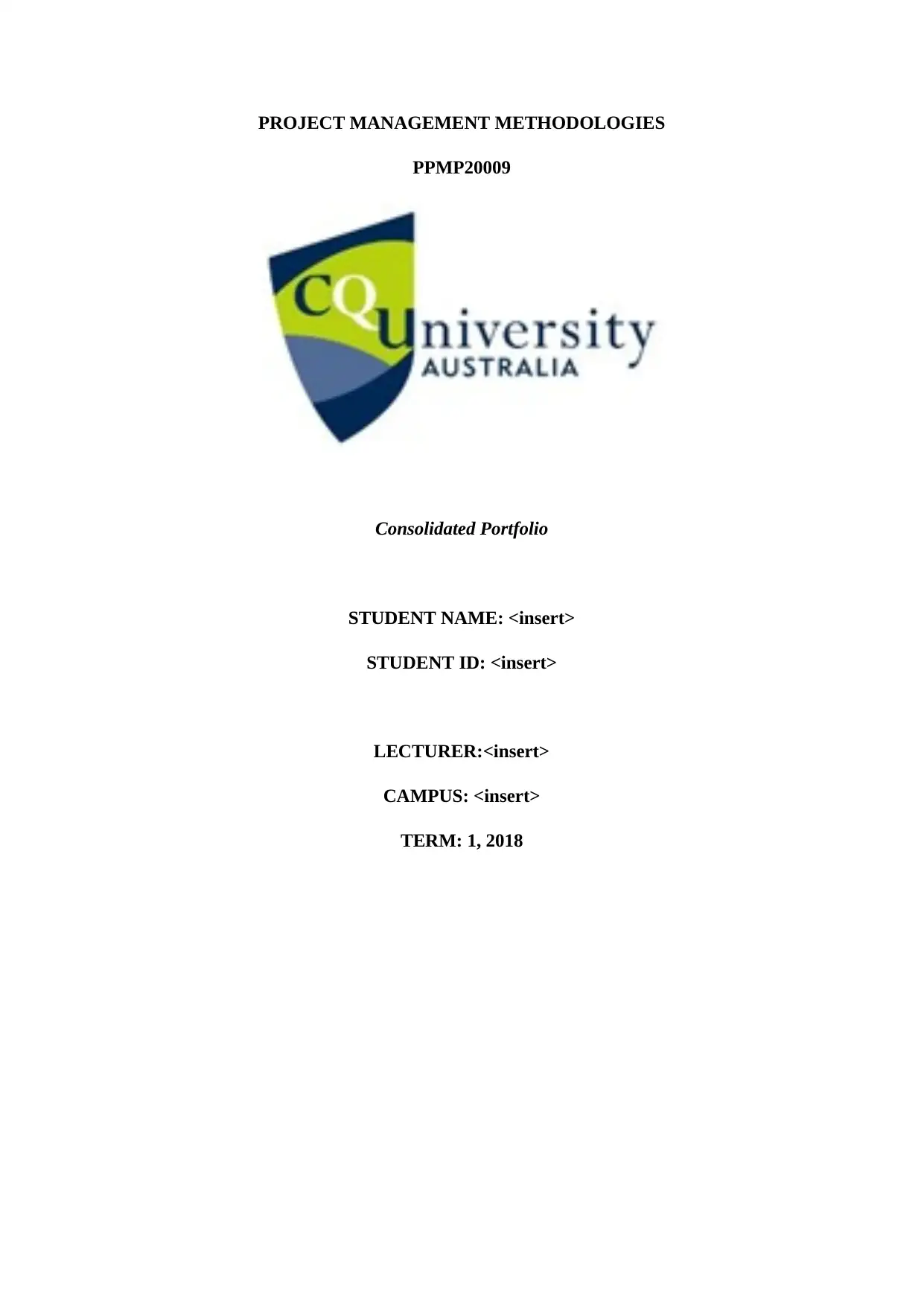
PROJECT MANAGEMENT METHODOLOGIES
PPMP20009
Consolidated Portfolio
STUDENT NAME: <insert>
STUDENT ID: <insert>
LECTURER:<insert>
CAMPUS: <insert>
TERM: 1, 2018
PPMP20009
Consolidated Portfolio
STUDENT NAME: <insert>
STUDENT ID: <insert>
LECTURER:<insert>
CAMPUS: <insert>
TERM: 1, 2018
Paraphrase This Document
Need a fresh take? Get an instant paraphrase of this document with our AI Paraphraser
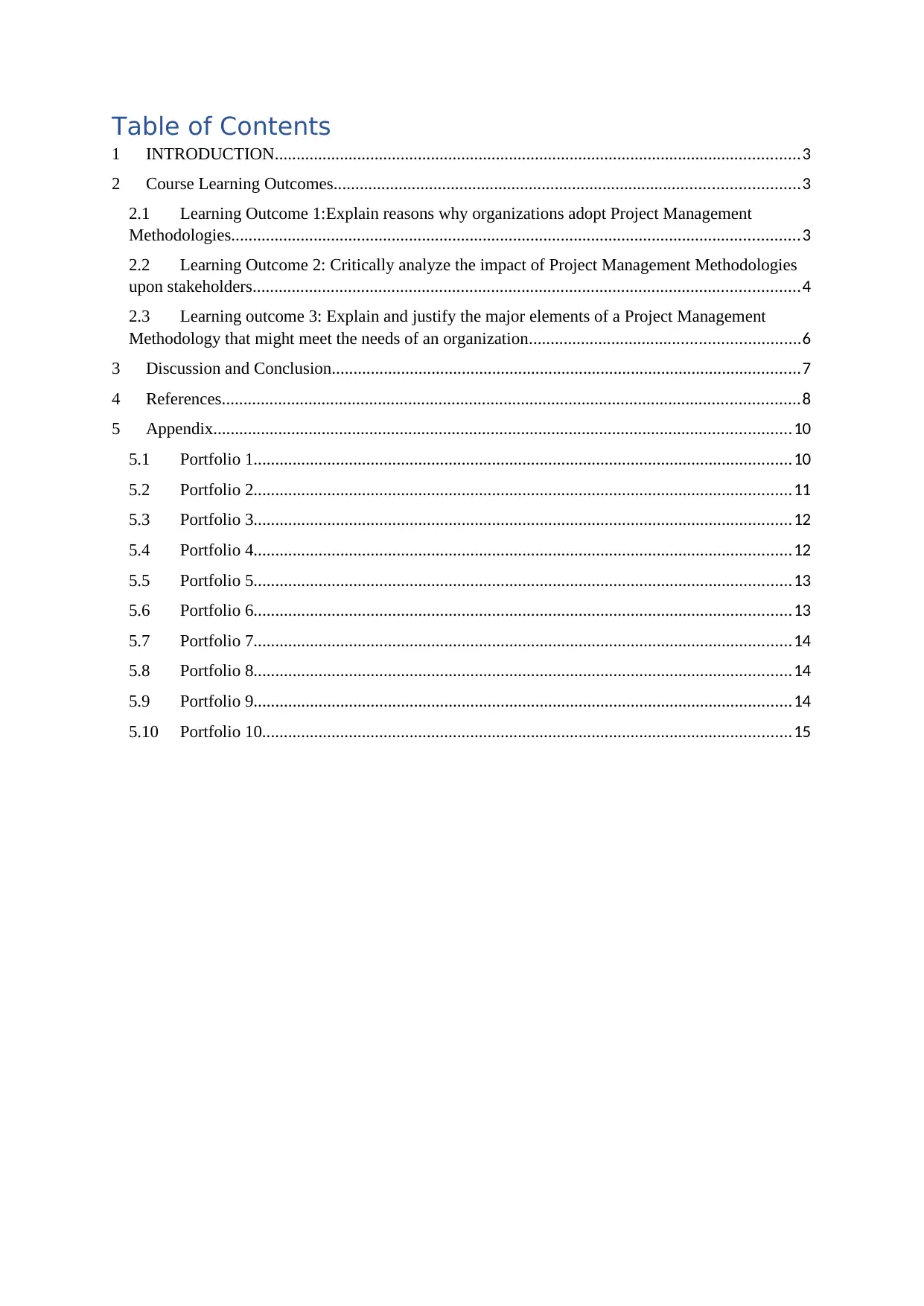
Table of Contents
1 INTRODUCTION.........................................................................................................................3
2 Course Learning Outcomes...........................................................................................................3
2.1 Learning Outcome 1:Explain reasons why organizations adopt Project Management
Methodologies...................................................................................................................................3
2.2 Learning Outcome 2: Critically analyze the impact of Project Management Methodologies
upon stakeholders..............................................................................................................................4
2.3 Learning outcome 3: Explain and justify the major elements of a Project Management
Methodology that might meet the needs of an organization..............................................................6
3 Discussion and Conclusion............................................................................................................7
4 References.....................................................................................................................................8
5 Appendix.....................................................................................................................................10
5.1 Portfolio 1............................................................................................................................10
5.2 Portfolio 2............................................................................................................................11
5.3 Portfolio 3............................................................................................................................12
5.4 Portfolio 4............................................................................................................................12
5.5 Portfolio 5............................................................................................................................13
5.6 Portfolio 6............................................................................................................................13
5.7 Portfolio 7............................................................................................................................14
5.8 Portfolio 8............................................................................................................................14
5.9 Portfolio 9............................................................................................................................14
5.10 Portfolio 10..........................................................................................................................15
1 INTRODUCTION.........................................................................................................................3
2 Course Learning Outcomes...........................................................................................................3
2.1 Learning Outcome 1:Explain reasons why organizations adopt Project Management
Methodologies...................................................................................................................................3
2.2 Learning Outcome 2: Critically analyze the impact of Project Management Methodologies
upon stakeholders..............................................................................................................................4
2.3 Learning outcome 3: Explain and justify the major elements of a Project Management
Methodology that might meet the needs of an organization..............................................................6
3 Discussion and Conclusion............................................................................................................7
4 References.....................................................................................................................................8
5 Appendix.....................................................................................................................................10
5.1 Portfolio 1............................................................................................................................10
5.2 Portfolio 2............................................................................................................................11
5.3 Portfolio 3............................................................................................................................12
5.4 Portfolio 4............................................................................................................................12
5.5 Portfolio 5............................................................................................................................13
5.6 Portfolio 6............................................................................................................................13
5.7 Portfolio 7............................................................................................................................14
5.8 Portfolio 8............................................................................................................................14
5.9 Portfolio 9............................................................................................................................14
5.10 Portfolio 10..........................................................................................................................15
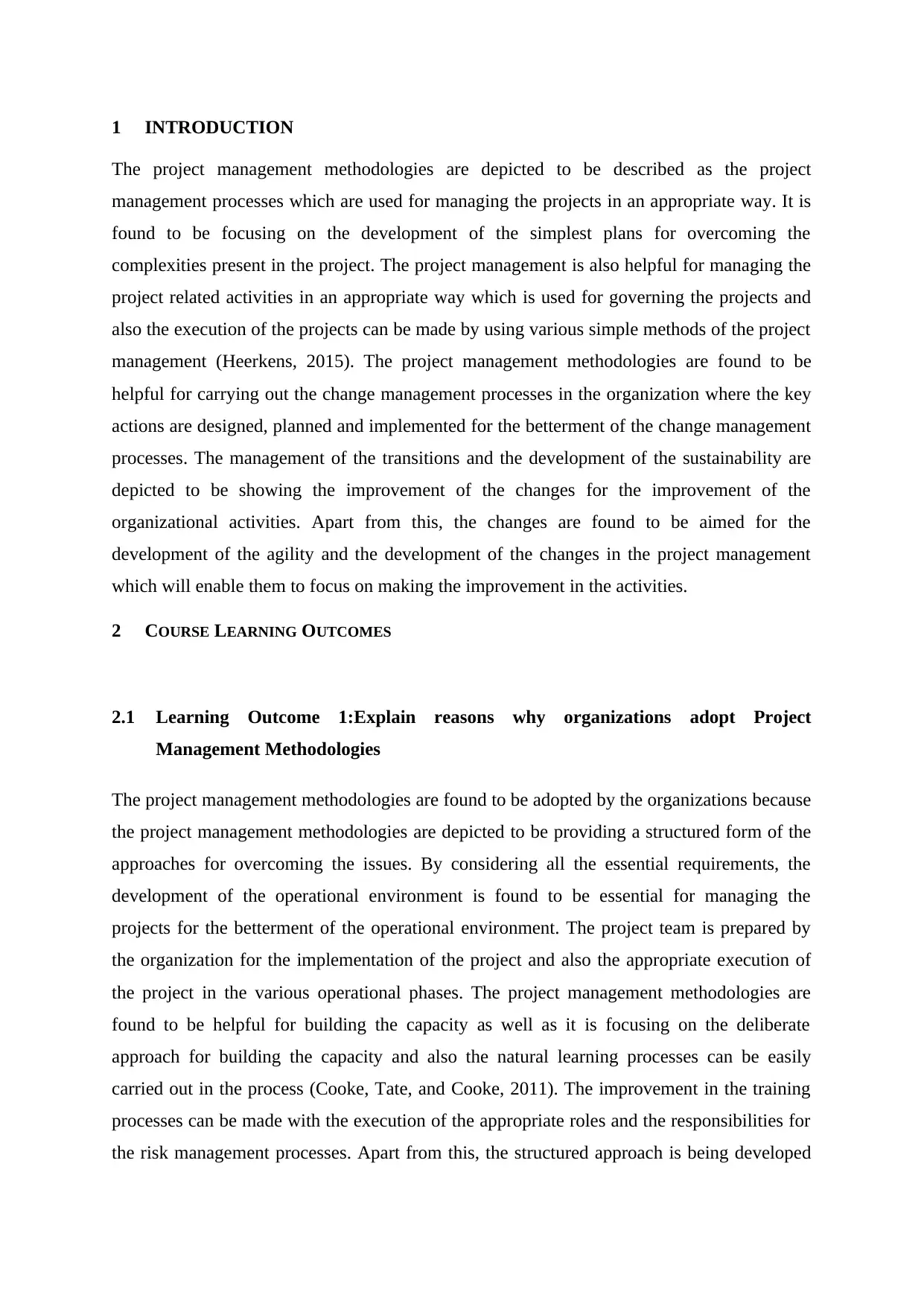
1 INTRODUCTION
The project management methodologies are depicted to be described as the project
management processes which are used for managing the projects in an appropriate way. It is
found to be focusing on the development of the simplest plans for overcoming the
complexities present in the project. The project management is also helpful for managing the
project related activities in an appropriate way which is used for governing the projects and
also the execution of the projects can be made by using various simple methods of the project
management (Heerkens, 2015). The project management methodologies are found to be
helpful for carrying out the change management processes in the organization where the key
actions are designed, planned and implemented for the betterment of the change management
processes. The management of the transitions and the development of the sustainability are
depicted to be showing the improvement of the changes for the improvement of the
organizational activities. Apart from this, the changes are found to be aimed for the
development of the agility and the development of the changes in the project management
which will enable them to focus on making the improvement in the activities.
2 COURSE LEARNING OUTCOMES
2.1 Learning Outcome 1:Explain reasons why organizations adopt Project
Management Methodologies
The project management methodologies are found to be adopted by the organizations because
the project management methodologies are depicted to be providing a structured form of the
approaches for overcoming the issues. By considering all the essential requirements, the
development of the operational environment is found to be essential for managing the
projects for the betterment of the operational environment. The project team is prepared by
the organization for the implementation of the project and also the appropriate execution of
the project in the various operational phases. The project management methodologies are
found to be helpful for building the capacity as well as it is focusing on the deliberate
approach for building the capacity and also the natural learning processes can be easily
carried out in the process (Cooke, Tate, and Cooke, 2011). The improvement in the training
processes can be made with the execution of the appropriate roles and the responsibilities for
the risk management processes. Apart from this, the structured approach is being developed
The project management methodologies are depicted to be described as the project
management processes which are used for managing the projects in an appropriate way. It is
found to be focusing on the development of the simplest plans for overcoming the
complexities present in the project. The project management is also helpful for managing the
project related activities in an appropriate way which is used for governing the projects and
also the execution of the projects can be made by using various simple methods of the project
management (Heerkens, 2015). The project management methodologies are found to be
helpful for carrying out the change management processes in the organization where the key
actions are designed, planned and implemented for the betterment of the change management
processes. The management of the transitions and the development of the sustainability are
depicted to be showing the improvement of the changes for the improvement of the
organizational activities. Apart from this, the changes are found to be aimed for the
development of the agility and the development of the changes in the project management
which will enable them to focus on making the improvement in the activities.
2 COURSE LEARNING OUTCOMES
2.1 Learning Outcome 1:Explain reasons why organizations adopt Project
Management Methodologies
The project management methodologies are found to be adopted by the organizations because
the project management methodologies are depicted to be providing a structured form of the
approaches for overcoming the issues. By considering all the essential requirements, the
development of the operational environment is found to be essential for managing the
projects for the betterment of the operational environment. The project team is prepared by
the organization for the implementation of the project and also the appropriate execution of
the project in the various operational phases. The project management methodologies are
found to be helpful for building the capacity as well as it is focusing on the deliberate
approach for building the capacity and also the natural learning processes can be easily
carried out in the process (Cooke, Tate, and Cooke, 2011). The improvement in the training
processes can be made with the execution of the appropriate roles and the responsibilities for
the risk management processes. Apart from this, the structured approach is being developed
⊘ This is a preview!⊘
Do you want full access?
Subscribe today to unlock all pages.

Trusted by 1+ million students worldwide
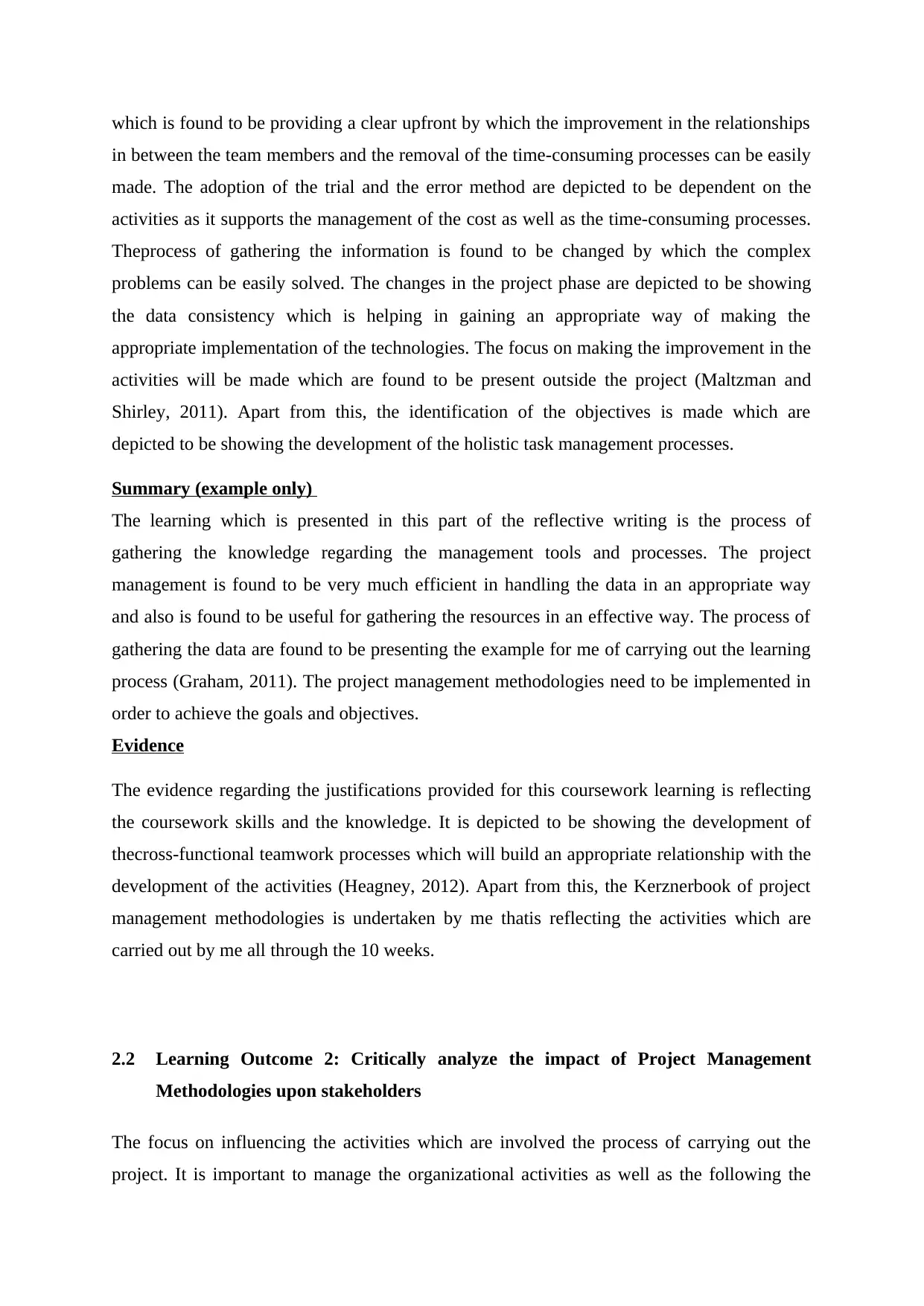
which is found to be providing a clear upfront by which the improvement in the relationships
in between the team members and the removal of the time-consuming processes can be easily
made. The adoption of the trial and the error method are depicted to be dependent on the
activities as it supports the management of the cost as well as the time-consuming processes.
Theprocess of gathering the information is found to be changed by which the complex
problems can be easily solved. The changes in the project phase are depicted to be showing
the data consistency which is helping in gaining an appropriate way of making the
appropriate implementation of the technologies. The focus on making the improvement in the
activities will be made which are found to be present outside the project (Maltzman and
Shirley, 2011). Apart from this, the identification of the objectives is made which are
depicted to be showing the development of the holistic task management processes.
Summary (example only)
The learning which is presented in this part of the reflective writing is the process of
gathering the knowledge regarding the management tools and processes. The project
management is found to be very much efficient in handling the data in an appropriate way
and also is found to be useful for gathering the resources in an effective way. The process of
gathering the data are found to be presenting the example for me of carrying out the learning
process (Graham, 2011). The project management methodologies need to be implemented in
order to achieve the goals and objectives.
Evidence
The evidence regarding the justifications provided for this coursework learning is reflecting
the coursework skills and the knowledge. It is depicted to be showing the development of
thecross-functional teamwork processes which will build an appropriate relationship with the
development of the activities (Heagney, 2012). Apart from this, the Kerznerbook of project
management methodologies is undertaken by me thatis reflecting the activities which are
carried out by me all through the 10 weeks.
2.2 Learning Outcome 2: Critically analyze the impact of Project Management
Methodologies upon stakeholders
The focus on influencing the activities which are involved the process of carrying out the
project. It is important to manage the organizational activities as well as the following the
in between the team members and the removal of the time-consuming processes can be easily
made. The adoption of the trial and the error method are depicted to be dependent on the
activities as it supports the management of the cost as well as the time-consuming processes.
Theprocess of gathering the information is found to be changed by which the complex
problems can be easily solved. The changes in the project phase are depicted to be showing
the data consistency which is helping in gaining an appropriate way of making the
appropriate implementation of the technologies. The focus on making the improvement in the
activities will be made which are found to be present outside the project (Maltzman and
Shirley, 2011). Apart from this, the identification of the objectives is made which are
depicted to be showing the development of the holistic task management processes.
Summary (example only)
The learning which is presented in this part of the reflective writing is the process of
gathering the knowledge regarding the management tools and processes. The project
management is found to be very much efficient in handling the data in an appropriate way
and also is found to be useful for gathering the resources in an effective way. The process of
gathering the data are found to be presenting the example for me of carrying out the learning
process (Graham, 2011). The project management methodologies need to be implemented in
order to achieve the goals and objectives.
Evidence
The evidence regarding the justifications provided for this coursework learning is reflecting
the coursework skills and the knowledge. It is depicted to be showing the development of
thecross-functional teamwork processes which will build an appropriate relationship with the
development of the activities (Heagney, 2012). Apart from this, the Kerznerbook of project
management methodologies is undertaken by me thatis reflecting the activities which are
carried out by me all through the 10 weeks.
2.2 Learning Outcome 2: Critically analyze the impact of Project Management
Methodologies upon stakeholders
The focus on influencing the activities which are involved the process of carrying out the
project. It is important to manage the organizational activities as well as the following the
Paraphrase This Document
Need a fresh take? Get an instant paraphrase of this document with our AI Paraphraser
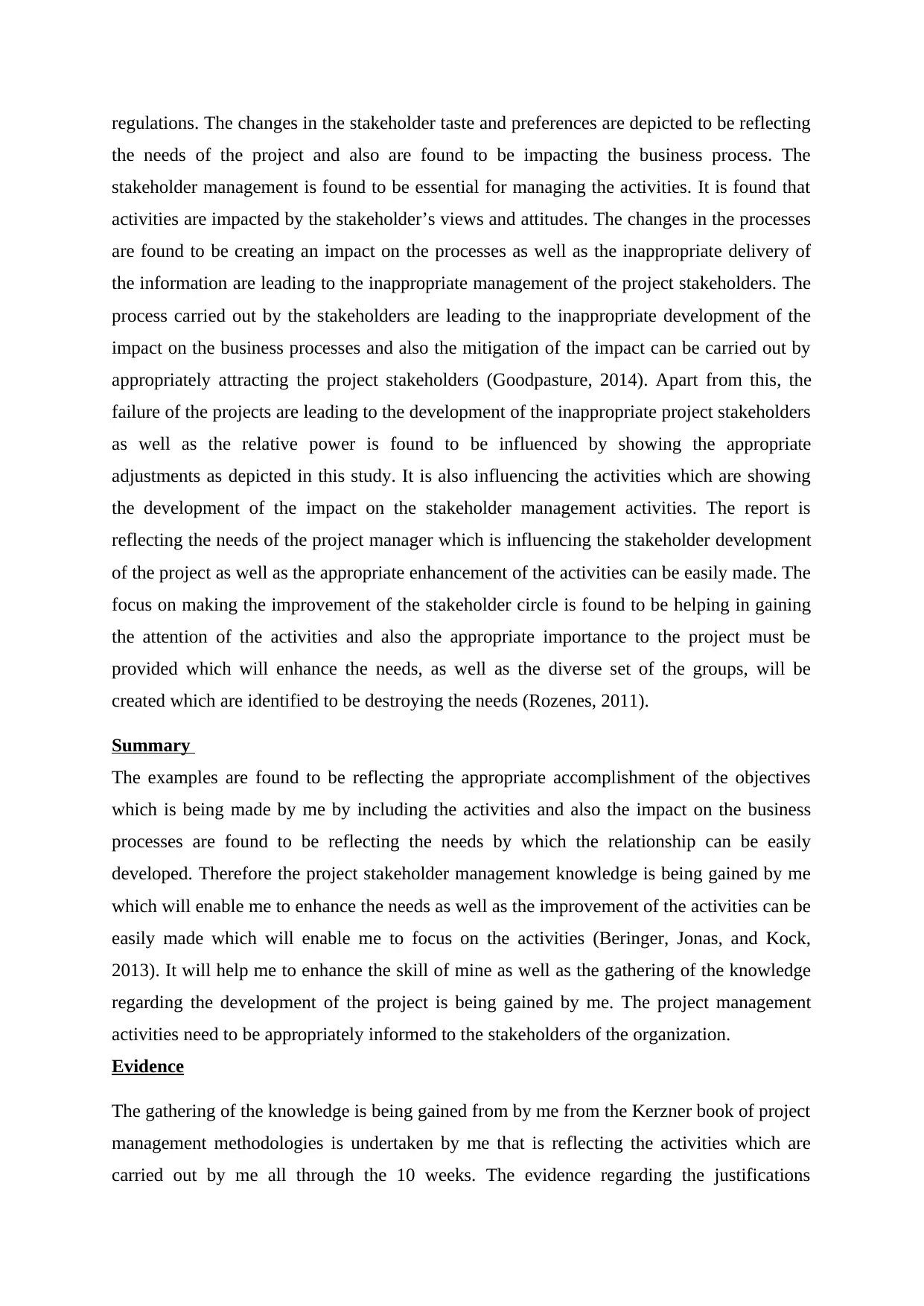
regulations. The changes in the stakeholder taste and preferences are depicted to be reflecting
the needs of the project and also are found to be impacting the business process. The
stakeholder management is found to be essential for managing the activities. It is found that
activities are impacted by the stakeholder’s views and attitudes. The changes in the processes
are found to be creating an impact on the processes as well as the inappropriate delivery of
the information are leading to the inappropriate management of the project stakeholders. The
process carried out by the stakeholders are leading to the inappropriate development of the
impact on the business processes and also the mitigation of the impact can be carried out by
appropriately attracting the project stakeholders (Goodpasture, 2014). Apart from this, the
failure of the projects are leading to the development of the inappropriate project stakeholders
as well as the relative power is found to be influenced by showing the appropriate
adjustments as depicted in this study. It is also influencing the activities which are showing
the development of the impact on the stakeholder management activities. The report is
reflecting the needs of the project manager which is influencing the stakeholder development
of the project as well as the appropriate enhancement of the activities can be easily made. The
focus on making the improvement of the stakeholder circle is found to be helping in gaining
the attention of the activities and also the appropriate importance to the project must be
provided which will enhance the needs, as well as the diverse set of the groups, will be
created which are identified to be destroying the needs (Rozenes, 2011).
Summary
The examples are found to be reflecting the appropriate accomplishment of the objectives
which is being made by me by including the activities and also the impact on the business
processes are found to be reflecting the needs by which the relationship can be easily
developed. Therefore the project stakeholder management knowledge is being gained by me
which will enable me to enhance the needs as well as the improvement of the activities can be
easily made which will enable me to focus on the activities (Beringer, Jonas, and Kock,
2013). It will help me to enhance the skill of mine as well as the gathering of the knowledge
regarding the development of the project is being gained by me. The project management
activities need to be appropriately informed to the stakeholders of the organization.
Evidence
The gathering of the knowledge is being gained from by me from the Kerzner book of project
management methodologies is undertaken by me that is reflecting the activities which are
carried out by me all through the 10 weeks. The evidence regarding the justifications
the needs of the project and also are found to be impacting the business process. The
stakeholder management is found to be essential for managing the activities. It is found that
activities are impacted by the stakeholder’s views and attitudes. The changes in the processes
are found to be creating an impact on the processes as well as the inappropriate delivery of
the information are leading to the inappropriate management of the project stakeholders. The
process carried out by the stakeholders are leading to the inappropriate development of the
impact on the business processes and also the mitigation of the impact can be carried out by
appropriately attracting the project stakeholders (Goodpasture, 2014). Apart from this, the
failure of the projects are leading to the development of the inappropriate project stakeholders
as well as the relative power is found to be influenced by showing the appropriate
adjustments as depicted in this study. It is also influencing the activities which are showing
the development of the impact on the stakeholder management activities. The report is
reflecting the needs of the project manager which is influencing the stakeholder development
of the project as well as the appropriate enhancement of the activities can be easily made. The
focus on making the improvement of the stakeholder circle is found to be helping in gaining
the attention of the activities and also the appropriate importance to the project must be
provided which will enhance the needs, as well as the diverse set of the groups, will be
created which are identified to be destroying the needs (Rozenes, 2011).
Summary
The examples are found to be reflecting the appropriate accomplishment of the objectives
which is being made by me by including the activities and also the impact on the business
processes are found to be reflecting the needs by which the relationship can be easily
developed. Therefore the project stakeholder management knowledge is being gained by me
which will enable me to enhance the needs as well as the improvement of the activities can be
easily made which will enable me to focus on the activities (Beringer, Jonas, and Kock,
2013). It will help me to enhance the skill of mine as well as the gathering of the knowledge
regarding the development of the project is being gained by me. The project management
activities need to be appropriately informed to the stakeholders of the organization.
Evidence
The gathering of the knowledge is being gained from by me from the Kerzner book of project
management methodologies is undertaken by me that is reflecting the activities which are
carried out by me all through the 10 weeks. The evidence regarding the justifications
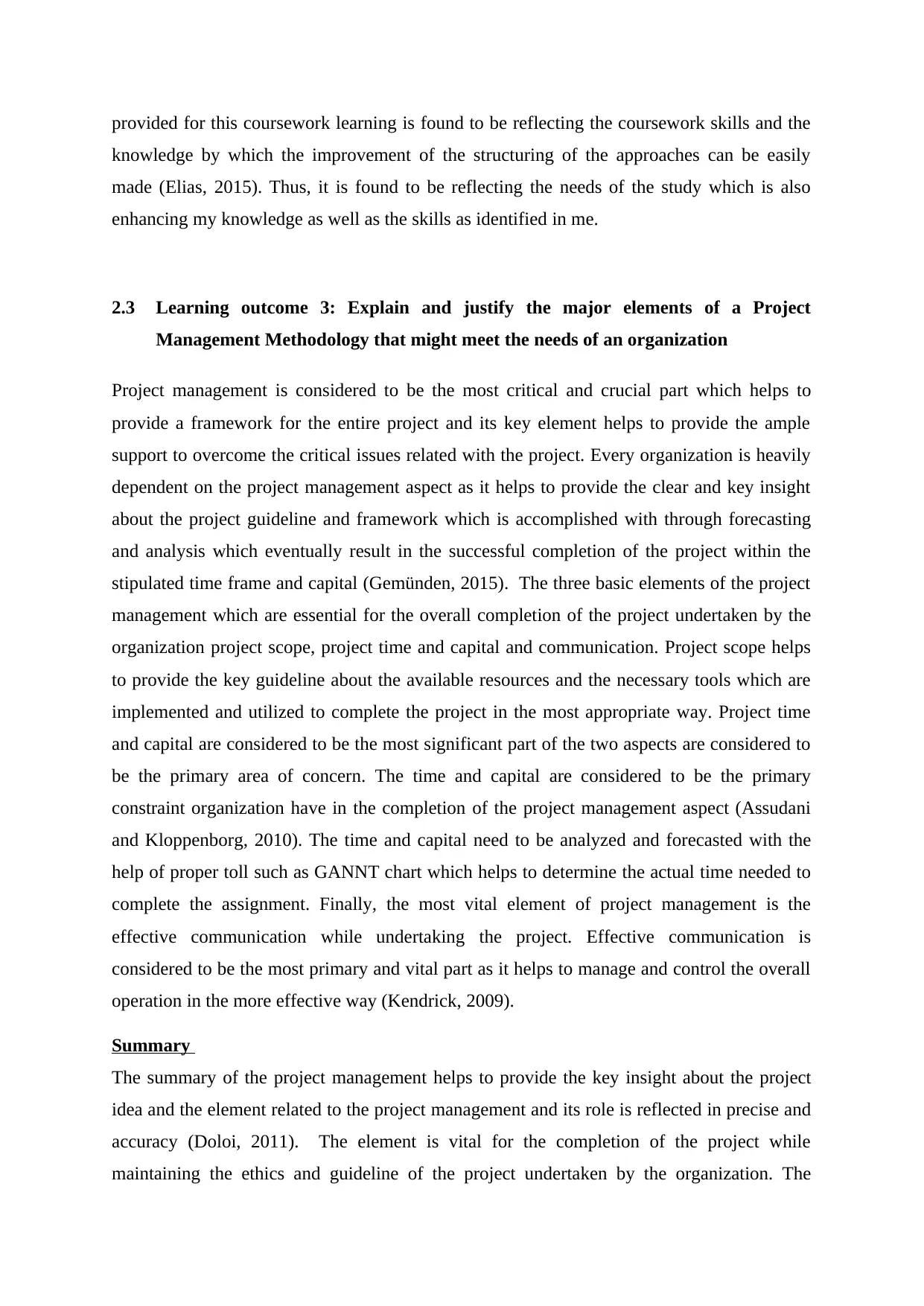
provided for this coursework learning is found to be reflecting the coursework skills and the
knowledge by which the improvement of the structuring of the approaches can be easily
made (Elias, 2015). Thus, it is found to be reflecting the needs of the study which is also
enhancing my knowledge as well as the skills as identified in me.
2.3 Learning outcome 3: Explain and justify the major elements of a Project
Management Methodology that might meet the needs of an organization
Project management is considered to be the most critical and crucial part which helps to
provide a framework for the entire project and its key element helps to provide the ample
support to overcome the critical issues related with the project. Every organization is heavily
dependent on the project management aspect as it helps to provide the clear and key insight
about the project guideline and framework which is accomplished with through forecasting
and analysis which eventually result in the successful completion of the project within the
stipulated time frame and capital (Gemünden, 2015). The three basic elements of the project
management which are essential for the overall completion of the project undertaken by the
organization project scope, project time and capital and communication. Project scope helps
to provide the key guideline about the available resources and the necessary tools which are
implemented and utilized to complete the project in the most appropriate way. Project time
and capital are considered to be the most significant part of the two aspects are considered to
be the primary area of concern. The time and capital are considered to be the primary
constraint organization have in the completion of the project management aspect (Assudani
and Kloppenborg, 2010). The time and capital need to be analyzed and forecasted with the
help of proper toll such as GANNT chart which helps to determine the actual time needed to
complete the assignment. Finally, the most vital element of project management is the
effective communication while undertaking the project. Effective communication is
considered to be the most primary and vital part as it helps to manage and control the overall
operation in the more effective way (Kendrick, 2009).
Summary
The summary of the project management helps to provide the key insight about the project
idea and the element related to the project management and its role is reflected in precise and
accuracy (Doloi, 2011). The element is vital for the completion of the project while
maintaining the ethics and guideline of the project undertaken by the organization. The
knowledge by which the improvement of the structuring of the approaches can be easily
made (Elias, 2015). Thus, it is found to be reflecting the needs of the study which is also
enhancing my knowledge as well as the skills as identified in me.
2.3 Learning outcome 3: Explain and justify the major elements of a Project
Management Methodology that might meet the needs of an organization
Project management is considered to be the most critical and crucial part which helps to
provide a framework for the entire project and its key element helps to provide the ample
support to overcome the critical issues related with the project. Every organization is heavily
dependent on the project management aspect as it helps to provide the clear and key insight
about the project guideline and framework which is accomplished with through forecasting
and analysis which eventually result in the successful completion of the project within the
stipulated time frame and capital (Gemünden, 2015). The three basic elements of the project
management which are essential for the overall completion of the project undertaken by the
organization project scope, project time and capital and communication. Project scope helps
to provide the key guideline about the available resources and the necessary tools which are
implemented and utilized to complete the project in the most appropriate way. Project time
and capital are considered to be the most significant part of the two aspects are considered to
be the primary area of concern. The time and capital are considered to be the primary
constraint organization have in the completion of the project management aspect (Assudani
and Kloppenborg, 2010). The time and capital need to be analyzed and forecasted with the
help of proper toll such as GANNT chart which helps to determine the actual time needed to
complete the assignment. Finally, the most vital element of project management is the
effective communication while undertaking the project. Effective communication is
considered to be the most primary and vital part as it helps to manage and control the overall
operation in the more effective way (Kendrick, 2009).
Summary
The summary of the project management helps to provide the key insight about the project
idea and the element related to the project management and its role is reflected in precise and
accuracy (Doloi, 2011). The element is vital for the completion of the project while
maintaining the ethics and guideline of the project undertaken by the organization. The
⊘ This is a preview!⊘
Do you want full access?
Subscribe today to unlock all pages.

Trusted by 1+ million students worldwide
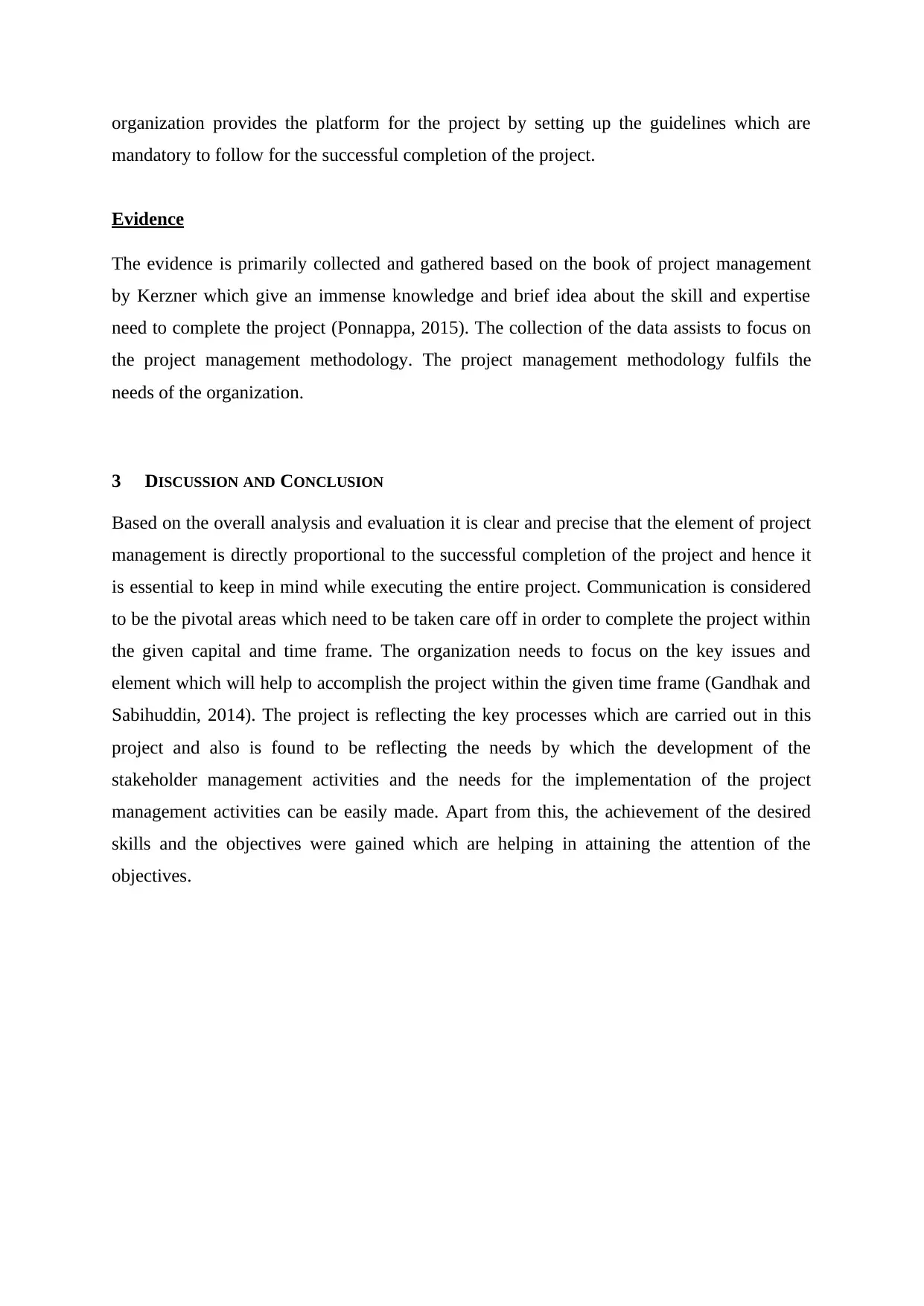
organization provides the platform for the project by setting up the guidelines which are
mandatory to follow for the successful completion of the project.
Evidence
The evidence is primarily collected and gathered based on the book of project management
by Kerzner which give an immense knowledge and brief idea about the skill and expertise
need to complete the project (Ponnappa, 2015). The collection of the data assists to focus on
the project management methodology. The project management methodology fulfils the
needs of the organization.
3 DISCUSSION AND CONCLUSION
Based on the overall analysis and evaluation it is clear and precise that the element of project
management is directly proportional to the successful completion of the project and hence it
is essential to keep in mind while executing the entire project. Communication is considered
to be the pivotal areas which need to be taken care off in order to complete the project within
the given capital and time frame. The organization needs to focus on the key issues and
element which will help to accomplish the project within the given time frame (Gandhak and
Sabihuddin, 2014). The project is reflecting the key processes which are carried out in this
project and also is found to be reflecting the needs by which the development of the
stakeholder management activities and the needs for the implementation of the project
management activities can be easily made. Apart from this, the achievement of the desired
skills and the objectives were gained which are helping in attaining the attention of the
objectives.
mandatory to follow for the successful completion of the project.
Evidence
The evidence is primarily collected and gathered based on the book of project management
by Kerzner which give an immense knowledge and brief idea about the skill and expertise
need to complete the project (Ponnappa, 2015). The collection of the data assists to focus on
the project management methodology. The project management methodology fulfils the
needs of the organization.
3 DISCUSSION AND CONCLUSION
Based on the overall analysis and evaluation it is clear and precise that the element of project
management is directly proportional to the successful completion of the project and hence it
is essential to keep in mind while executing the entire project. Communication is considered
to be the pivotal areas which need to be taken care off in order to complete the project within
the given capital and time frame. The organization needs to focus on the key issues and
element which will help to accomplish the project within the given time frame (Gandhak and
Sabihuddin, 2014). The project is reflecting the key processes which are carried out in this
project and also is found to be reflecting the needs by which the development of the
stakeholder management activities and the needs for the implementation of the project
management activities can be easily made. Apart from this, the achievement of the desired
skills and the objectives were gained which are helping in attaining the attention of the
objectives.
Paraphrase This Document
Need a fresh take? Get an instant paraphrase of this document with our AI Paraphraser
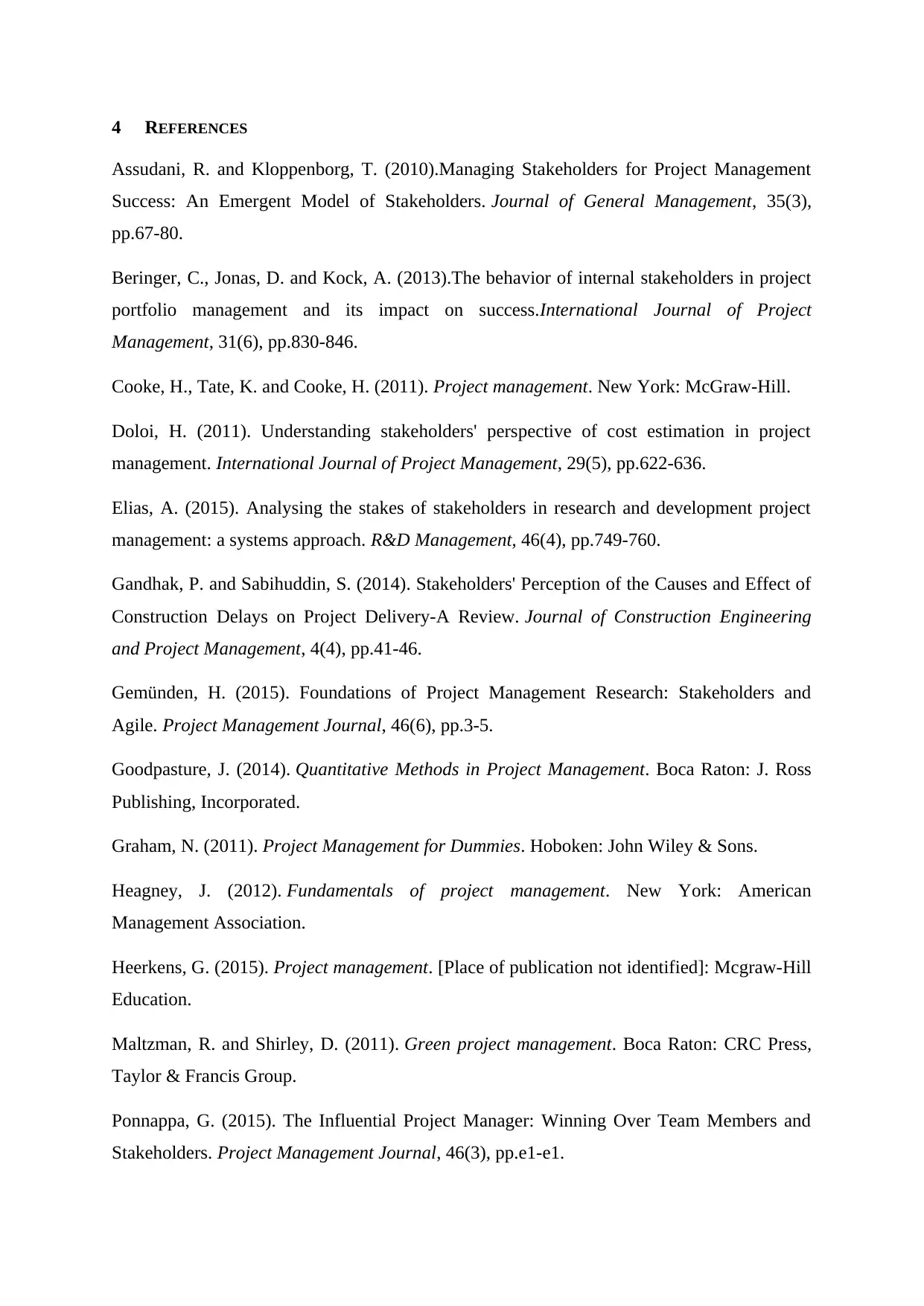
4 REFERENCES
Assudani, R. and Kloppenborg, T. (2010).Managing Stakeholders for Project Management
Success: An Emergent Model of Stakeholders. Journal of General Management, 35(3),
pp.67-80.
Beringer, C., Jonas, D. and Kock, A. (2013).The behavior of internal stakeholders in project
portfolio management and its impact on success.International Journal of Project
Management, 31(6), pp.830-846.
Cooke, H., Tate, K. and Cooke, H. (2011). Project management. New York: McGraw-Hill.
Doloi, H. (2011). Understanding stakeholders' perspective of cost estimation in project
management. International Journal of Project Management, 29(5), pp.622-636.
Elias, A. (2015). Analysing the stakes of stakeholders in research and development project
management: a systems approach. R&D Management, 46(4), pp.749-760.
Gandhak, P. and Sabihuddin, S. (2014). Stakeholders' Perception of the Causes and Effect of
Construction Delays on Project Delivery-A Review. Journal of Construction Engineering
and Project Management, 4(4), pp.41-46.
Gemünden, H. (2015). Foundations of Project Management Research: Stakeholders and
Agile. Project Management Journal, 46(6), pp.3-5.
Goodpasture, J. (2014). Quantitative Methods in Project Management. Boca Raton: J. Ross
Publishing, Incorporated.
Graham, N. (2011). Project Management for Dummies. Hoboken: John Wiley & Sons.
Heagney, J. (2012). Fundamentals of project management. New York: American
Management Association.
Heerkens, G. (2015). Project management. [Place of publication not identified]: Mcgraw-Hill
Education.
Maltzman, R. and Shirley, D. (2011). Green project management. Boca Raton: CRC Press,
Taylor & Francis Group.
Ponnappa, G. (2015). The Influential Project Manager: Winning Over Team Members and
Stakeholders. Project Management Journal, 46(3), pp.e1-e1.
Assudani, R. and Kloppenborg, T. (2010).Managing Stakeholders for Project Management
Success: An Emergent Model of Stakeholders. Journal of General Management, 35(3),
pp.67-80.
Beringer, C., Jonas, D. and Kock, A. (2013).The behavior of internal stakeholders in project
portfolio management and its impact on success.International Journal of Project
Management, 31(6), pp.830-846.
Cooke, H., Tate, K. and Cooke, H. (2011). Project management. New York: McGraw-Hill.
Doloi, H. (2011). Understanding stakeholders' perspective of cost estimation in project
management. International Journal of Project Management, 29(5), pp.622-636.
Elias, A. (2015). Analysing the stakes of stakeholders in research and development project
management: a systems approach. R&D Management, 46(4), pp.749-760.
Gandhak, P. and Sabihuddin, S. (2014). Stakeholders' Perception of the Causes and Effect of
Construction Delays on Project Delivery-A Review. Journal of Construction Engineering
and Project Management, 4(4), pp.41-46.
Gemünden, H. (2015). Foundations of Project Management Research: Stakeholders and
Agile. Project Management Journal, 46(6), pp.3-5.
Goodpasture, J. (2014). Quantitative Methods in Project Management. Boca Raton: J. Ross
Publishing, Incorporated.
Graham, N. (2011). Project Management for Dummies. Hoboken: John Wiley & Sons.
Heagney, J. (2012). Fundamentals of project management. New York: American
Management Association.
Heerkens, G. (2015). Project management. [Place of publication not identified]: Mcgraw-Hill
Education.
Maltzman, R. and Shirley, D. (2011). Green project management. Boca Raton: CRC Press,
Taylor & Francis Group.
Ponnappa, G. (2015). The Influential Project Manager: Winning Over Team Members and
Stakeholders. Project Management Journal, 46(3), pp.e1-e1.
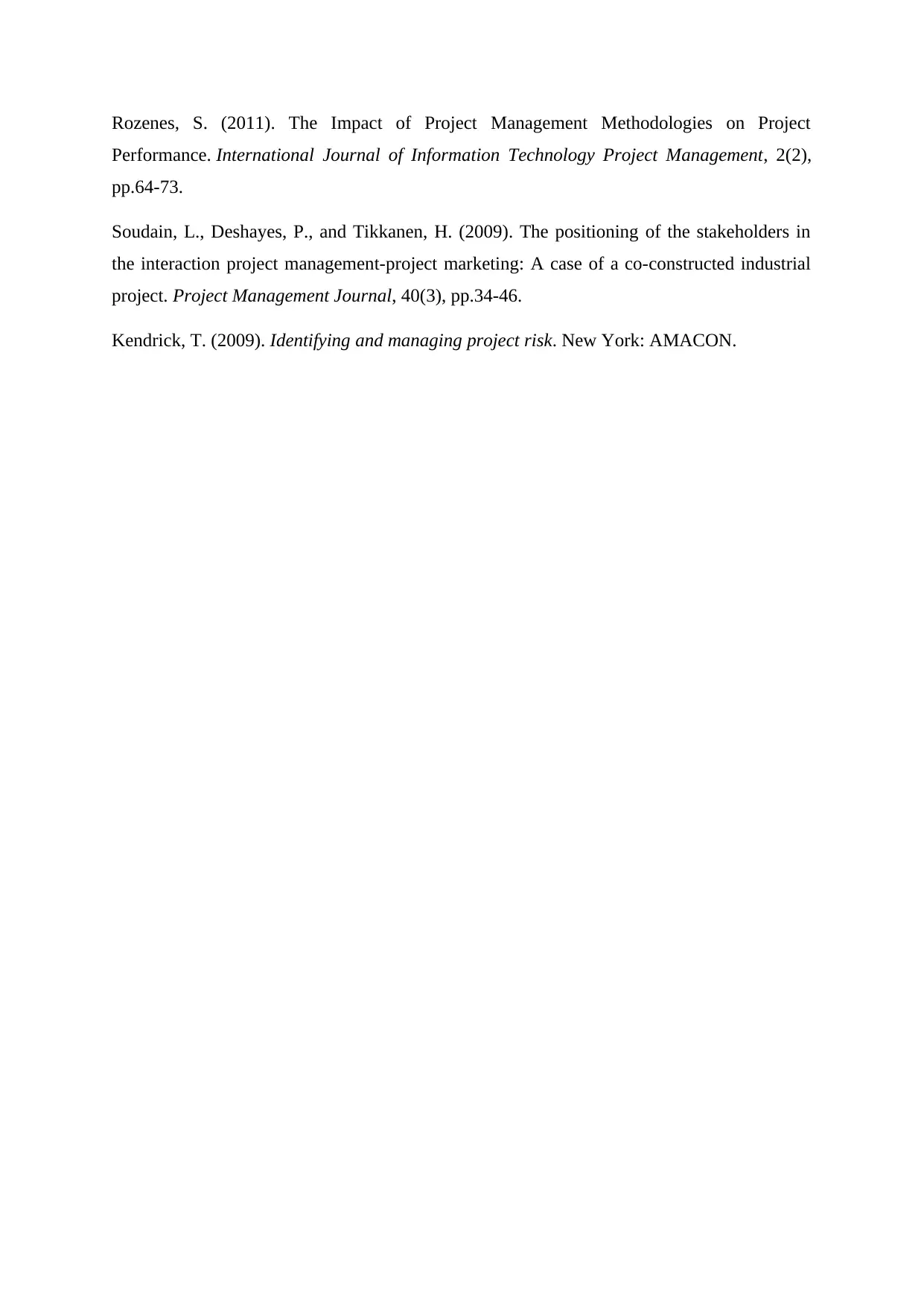
Rozenes, S. (2011). The Impact of Project Management Methodologies on Project
Performance. International Journal of Information Technology Project Management, 2(2),
pp.64-73.
Soudain, L., Deshayes, P., and Tikkanen, H. (2009). The positioning of the stakeholders in
the interaction project management-project marketing: A case of a co-constructed industrial
project. Project Management Journal, 40(3), pp.34-46.
Kendrick, T. (2009). Identifying and managing project risk. New York: AMACON.
Performance. International Journal of Information Technology Project Management, 2(2),
pp.64-73.
Soudain, L., Deshayes, P., and Tikkanen, H. (2009). The positioning of the stakeholders in
the interaction project management-project marketing: A case of a co-constructed industrial
project. Project Management Journal, 40(3), pp.34-46.
Kendrick, T. (2009). Identifying and managing project risk. New York: AMACON.
⊘ This is a preview!⊘
Do you want full access?
Subscribe today to unlock all pages.

Trusted by 1+ million students worldwide
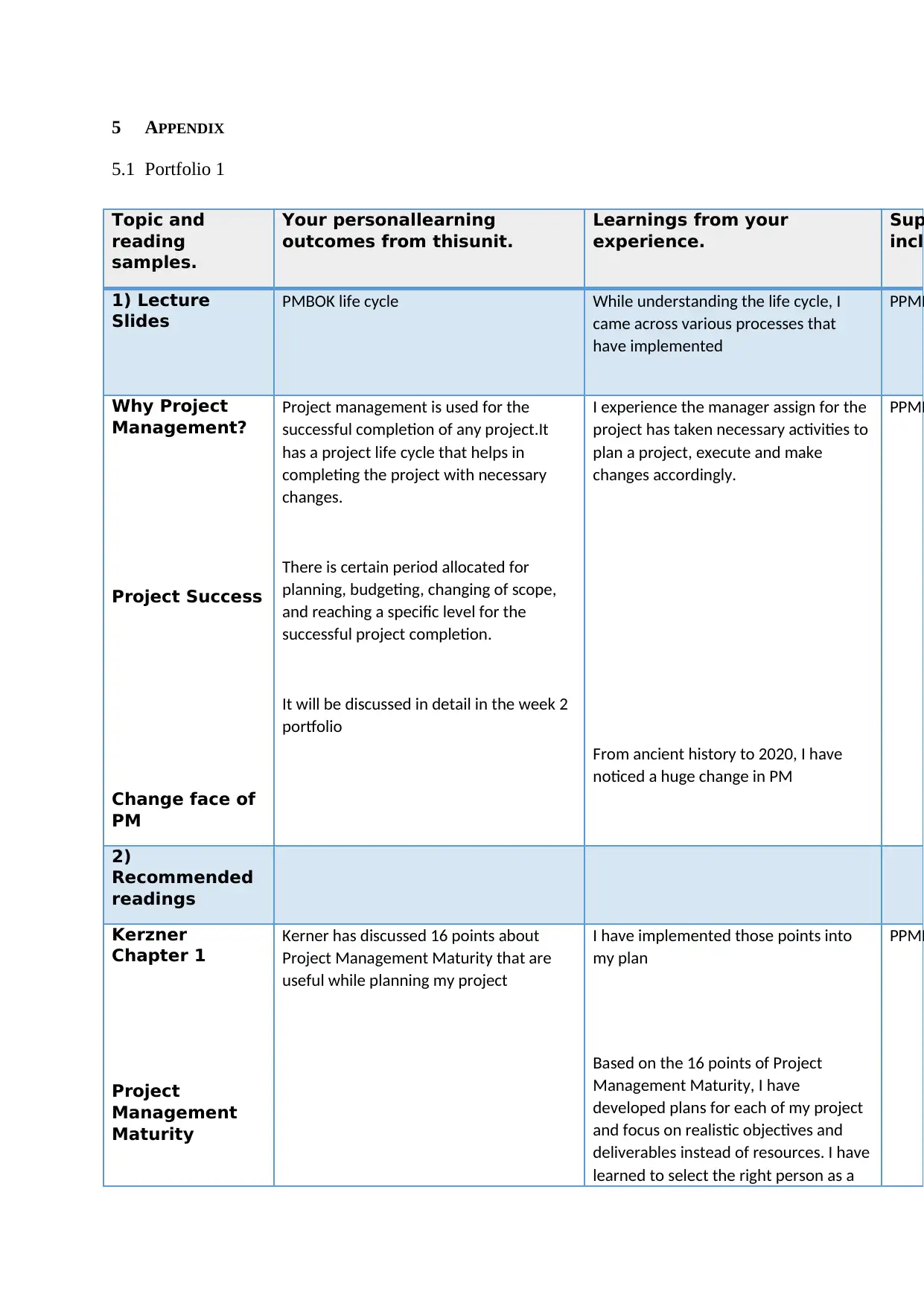
5 APPENDIX
5.1 Portfolio 1
Topic and
reading
samples.
Your personallearning
outcomes from thisunit.
Learnings from your
experience.
Sup
incl
1) Lecture
Slides
PMBOK life cycle While understanding the life cycle, I
came across various processes that
have implemented
PPMP
Why Project
Management?
Project Success
Change face of
PM
Project management is used for the
successful completion of any project.It
has a project life cycle that helps in
completing the project with necessary
changes.
There is certain period allocated for
planning, budgeting, changing of scope,
and reaching a specific level for the
successful project completion.
It will be discussed in detail in the week 2
portfolio
I experience the manager assign for the
project has taken necessary activities to
plan a project, execute and make
changes accordingly.
From ancient history to 2020, I have
noticed a huge change in PM
PPMP
2)
Recommended
readings
Kerzner
Chapter 1
Project
Management
Maturity
Kerner has discussed 16 points about
Project Management Maturity that are
useful while planning my project
I have implemented those points into
my plan
Based on the 16 points of Project
Management Maturity, I have
developed plans for each of my project
and focus on realistic objectives and
deliverables instead of resources. I have
learned to select the right person as a
PPMP
5.1 Portfolio 1
Topic and
reading
samples.
Your personallearning
outcomes from thisunit.
Learnings from your
experience.
Sup
incl
1) Lecture
Slides
PMBOK life cycle While understanding the life cycle, I
came across various processes that
have implemented
PPMP
Why Project
Management?
Project Success
Change face of
PM
Project management is used for the
successful completion of any project.It
has a project life cycle that helps in
completing the project with necessary
changes.
There is certain period allocated for
planning, budgeting, changing of scope,
and reaching a specific level for the
successful project completion.
It will be discussed in detail in the week 2
portfolio
I experience the manager assign for the
project has taken necessary activities to
plan a project, execute and make
changes accordingly.
From ancient history to 2020, I have
noticed a huge change in PM
PPMP
2)
Recommended
readings
Kerzner
Chapter 1
Project
Management
Maturity
Kerner has discussed 16 points about
Project Management Maturity that are
useful while planning my project
I have implemented those points into
my plan
Based on the 16 points of Project
Management Maturity, I have
developed plans for each of my project
and focus on realistic objectives and
deliverables instead of resources. I have
learned to select the right person as a
PPMP
Paraphrase This Document
Need a fresh take? Get an instant paraphrase of this document with our AI Paraphraser
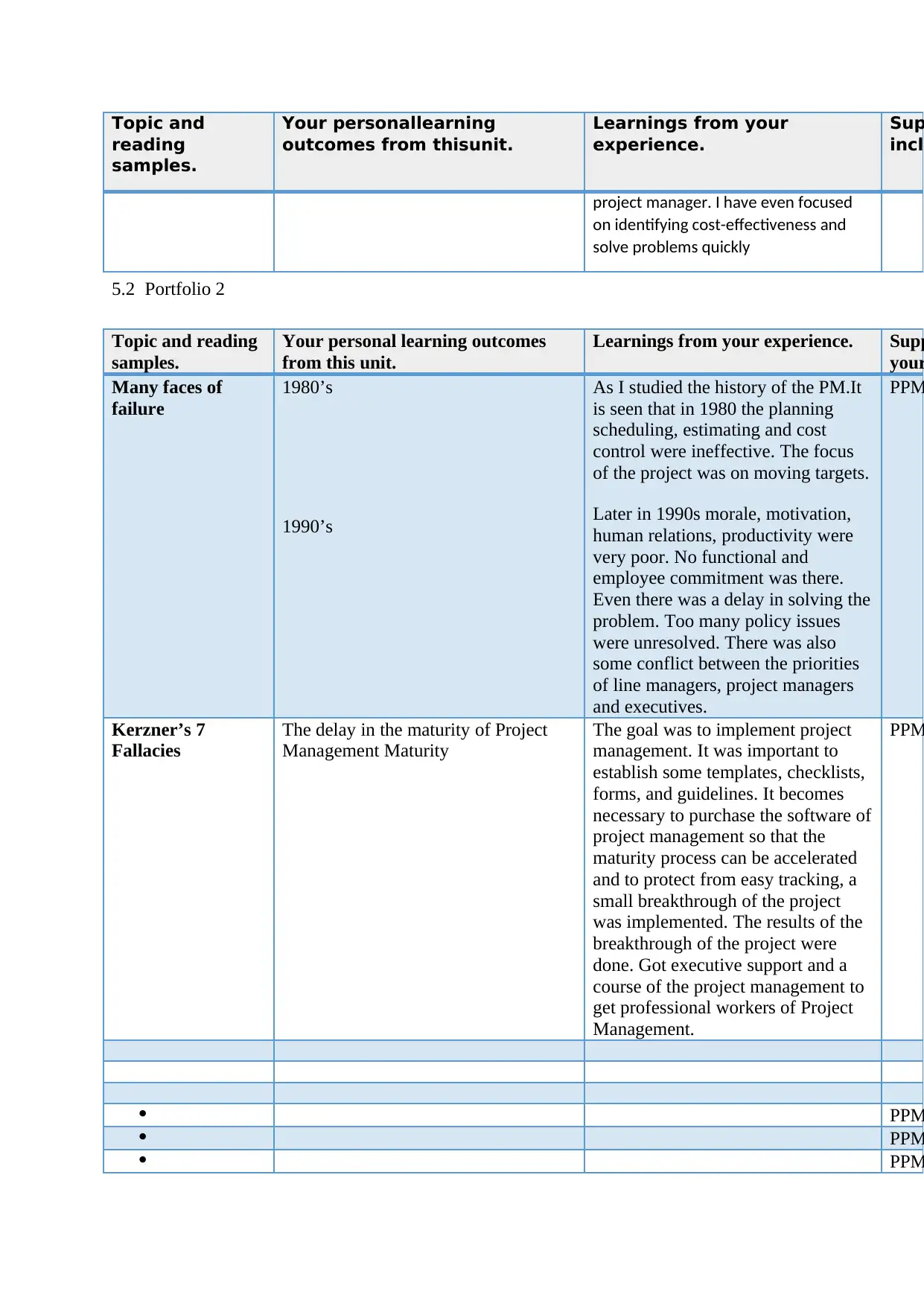
Topic and
reading
samples.
Your personallearning
outcomes from thisunit.
Learnings from your
experience.
Sup
incl
project manager. I have even focused
on identifying cost-effectiveness and
solve problems quickly
5.2 Portfolio 2
Topic and reading
samples.
Your personal learning outcomes
from this unit.
Learnings from your experience. Supp
your
Many faces of
failure
1980’s
1990’s
As I studied the history of the PM.It
is seen that in 1980 the planning
scheduling, estimating and cost
control were ineffective. The focus
of the project was on moving targets.
Later in 1990s morale, motivation,
human relations, productivity were
very poor. No functional and
employee commitment was there.
Even there was a delay in solving the
problem. Too many policy issues
were unresolved. There was also
some conflict between the priorities
of line managers, project managers
and executives.
PPM
Kerzner’s 7
Fallacies
The delay in the maturity of Project
Management Maturity
The goal was to implement project
management. It was important to
establish some templates, checklists,
forms, and guidelines. It becomes
necessary to purchase the software of
project management so that the
maturity process can be accelerated
and to protect from easy tracking, a
small breakthrough of the project
was implemented. The results of the
breakthrough of the project were
done. Got executive support and a
course of the project management to
get professional workers of Project
Management.
PPM
PPM
PPM
PPM
reading
samples.
Your personallearning
outcomes from thisunit.
Learnings from your
experience.
Sup
incl
project manager. I have even focused
on identifying cost-effectiveness and
solve problems quickly
5.2 Portfolio 2
Topic and reading
samples.
Your personal learning outcomes
from this unit.
Learnings from your experience. Supp
your
Many faces of
failure
1980’s
1990’s
As I studied the history of the PM.It
is seen that in 1980 the planning
scheduling, estimating and cost
control were ineffective. The focus
of the project was on moving targets.
Later in 1990s morale, motivation,
human relations, productivity were
very poor. No functional and
employee commitment was there.
Even there was a delay in solving the
problem. Too many policy issues
were unresolved. There was also
some conflict between the priorities
of line managers, project managers
and executives.
PPM
Kerzner’s 7
Fallacies
The delay in the maturity of Project
Management Maturity
The goal was to implement project
management. It was important to
establish some templates, checklists,
forms, and guidelines. It becomes
necessary to purchase the software of
project management so that the
maturity process can be accelerated
and to protect from easy tracking, a
small breakthrough of the project
was implemented. The results of the
breakthrough of the project were
done. Got executive support and a
course of the project management to
get professional workers of Project
Management.
PPM
PPM
PPM
PPM
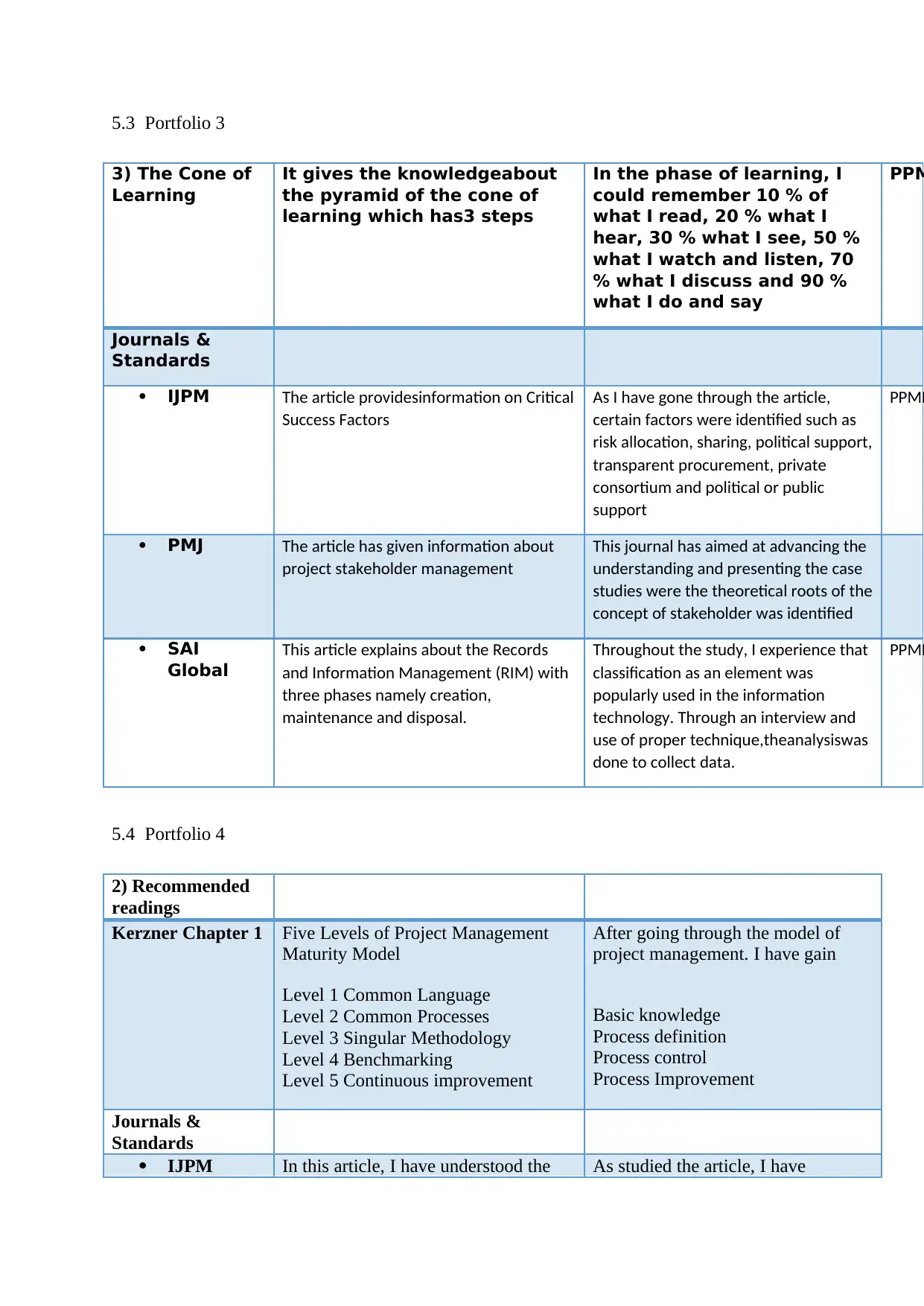
5.3 Portfolio 3
3) The Cone of
Learning
It gives the knowledgeabout
the pyramid of the cone of
learning which has3 steps
In the phase of learning, I
could remember 10 % of
what I read, 20 % what I
hear, 30 % what I see, 50 %
what I watch and listen, 70
% what I discuss and 90 %
what I do and say
PPM
Journals &
Standards
IJPM The article providesinformation on Critical
Success Factors
As I have gone through the article,
certain factors were identified such as
risk allocation, sharing, political support,
transparent procurement, private
consortium and political or public
support
PPMP
PMJ The article has given information about
project stakeholder management
This journal has aimed at advancing the
understanding and presenting the case
studies were the theoretical roots of the
concept of stakeholder was identified
SAI
Global
This article explains about the Records
and Information Management (RIM) with
three phases namely creation,
maintenance and disposal.
Throughout the study, I experience that
classification as an element was
popularly used in the information
technology. Through an interview and
use of proper technique,theanalysiswas
done to collect data.
PPMP
5.4 Portfolio 4
2) Recommended
readings
Kerzner Chapter 1 Five Levels of Project Management
Maturity Model
Level 1 Common Language
Level 2 Common Processes
Level 3 Singular Methodology
Level 4 Benchmarking
Level 5 Continuous improvement
After going through the model of
project management. I have gain
Basic knowledge
Process definition
Process control
Process Improvement
Journals &
Standards
IJPM In this article, I have understood the As studied the article, I have
3) The Cone of
Learning
It gives the knowledgeabout
the pyramid of the cone of
learning which has3 steps
In the phase of learning, I
could remember 10 % of
what I read, 20 % what I
hear, 30 % what I see, 50 %
what I watch and listen, 70
% what I discuss and 90 %
what I do and say
PPM
Journals &
Standards
IJPM The article providesinformation on Critical
Success Factors
As I have gone through the article,
certain factors were identified such as
risk allocation, sharing, political support,
transparent procurement, private
consortium and political or public
support
PPMP
PMJ The article has given information about
project stakeholder management
This journal has aimed at advancing the
understanding and presenting the case
studies were the theoretical roots of the
concept of stakeholder was identified
SAI
Global
This article explains about the Records
and Information Management (RIM) with
three phases namely creation,
maintenance and disposal.
Throughout the study, I experience that
classification as an element was
popularly used in the information
technology. Through an interview and
use of proper technique,theanalysiswas
done to collect data.
PPMP
5.4 Portfolio 4
2) Recommended
readings
Kerzner Chapter 1 Five Levels of Project Management
Maturity Model
Level 1 Common Language
Level 2 Common Processes
Level 3 Singular Methodology
Level 4 Benchmarking
Level 5 Continuous improvement
After going through the model of
project management. I have gain
Basic knowledge
Process definition
Process control
Process Improvement
Journals &
Standards
IJPM In this article, I have understood the As studied the article, I have
⊘ This is a preview!⊘
Do you want full access?
Subscribe today to unlock all pages.

Trusted by 1+ million students worldwide
1 out of 16
Related Documents
Your All-in-One AI-Powered Toolkit for Academic Success.
+13062052269
info@desklib.com
Available 24*7 on WhatsApp / Email
![[object Object]](/_next/static/media/star-bottom.7253800d.svg)
Unlock your academic potential
Copyright © 2020–2025 A2Z Services. All Rights Reserved. Developed and managed by ZUCOL.

